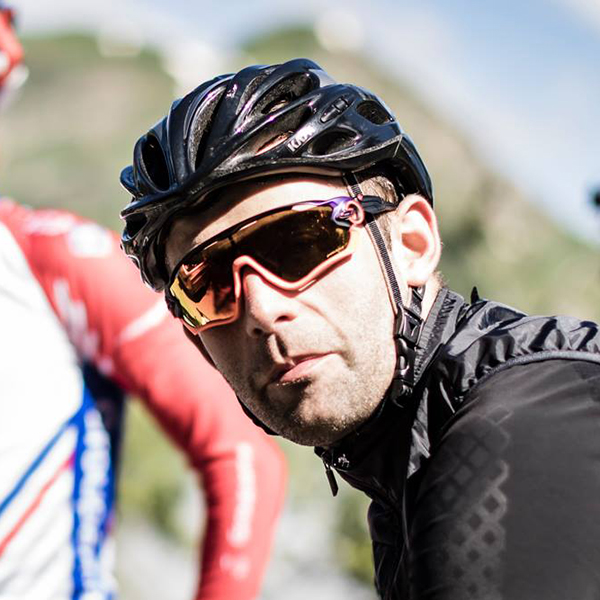Shimano 105 Di2 R7100 launched with some fanfare in the summer of 2022, carrying the hopes of many Shimano users who wanted a cheaper access point to the brand’s electronic shifting system.
It aimed to take much of Shimano’s higher-tier groupset technology and distil it into a more affordable package.
On the whole, it succeeds in its aims – it's a very competent groupset, and if you shop around for a deal, it has a case to claim to be the best value electronic road bike groupset available today.
Unlike Ultegra Di2 R8170, which performs practically identically to Dura-Ace Di2 R9200, 105 Di2 R7100 has made a few small concessions to hit its lower-cost price point.
Having said that, if you can put up with those (and I bet many can), then it’s probably the best value electronic groupset to buy, if – when you read this – it can be bought for a price similar or cheaper to SRAM’s nominal opponent, Rival AXS.
Setup

Shimano 105 Di2 R7100 brought electronic shifting to Shimano’s third-tier road groupset level, and importantly for some, it ported over the wireless shifters seen on the latest generation Dura-Ace and Ultegra groupsets.
This means there’s no cable routing to worry about from the shifters to the derailleur and battery system.
Like the sibling groupsets, the brains of the system live in the rear derailleur, so there’s no junction box in the mix either.
As my colleague, Simon von Bromley, pointed out in his review of the brand’s flagship groupset, Dura-Ace Di2 R9200, moving to a semi-wireless system reduces the chance of issues with adjustment, servicing and routing at the front end of the bike (excepting the continued presence of brake hoses).
The front and rear derailleurs are connected to each other and the central battery via wires. The battery is commonly housed just above the bottom bracket in the seat tube or, as in the case of my Fairlight Strael 3.0 test bike, in the seatpost.
This approach contrasts with SRAM’s modular design across Red eTap AXS, Force AXS, Rival eTap AXS, and Apex AXS, where each derailleur gets its own separate battery.
Shimano’s E-Tube Project app connects to the system just like the Dura-Ace and Ultegra Di2 groupsets, offering indexing and limit setting functionality, and more.
Indexing can also be done manually. The physical button on the rear derailleur can be used to enter adjustment mode, after which micro-adjustments can be made using the shifter paddles.
Shimano 105 Di2 R7100 drivetrain performance
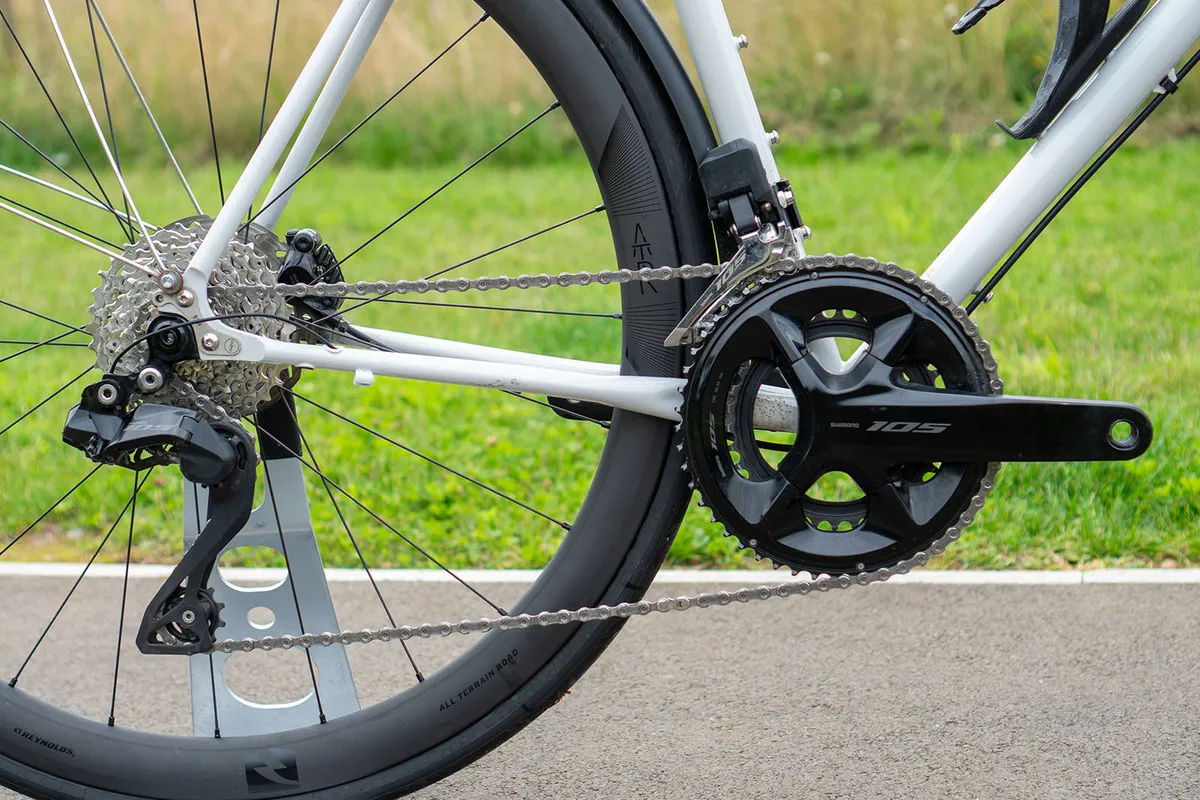
Where it really matters, 105 Di2 R7100 brings the same functionality and crisp performance as Dura-Ace Di2 R9200 and Ultegra Di2 R8170.
There are small differences in shift speed, which is detectable at the front derailleur and in the drivetrain smoothness compared to Ultegra Di2 (remember, that groupset is practically indistinguishable from Dura-Ace Di2).
The 105 Di2 levers also miss the customisable hood-top buttons seen on the more expensive groupsets, but unless you’ve already grown to rely on them, this is hardly a deal-breaker.
Braking is also very good despite not featuring Shimano’s Servo Wave tech, but more on that later.
In all, the drivetrain packs in the fundamental level of performance Shimano’s electronic shifting system is renowned for, with near-equal levels of polish and slickness attributed to its higher-tier brethren.
Shimano 105 Di2 ST-R7170 shifters
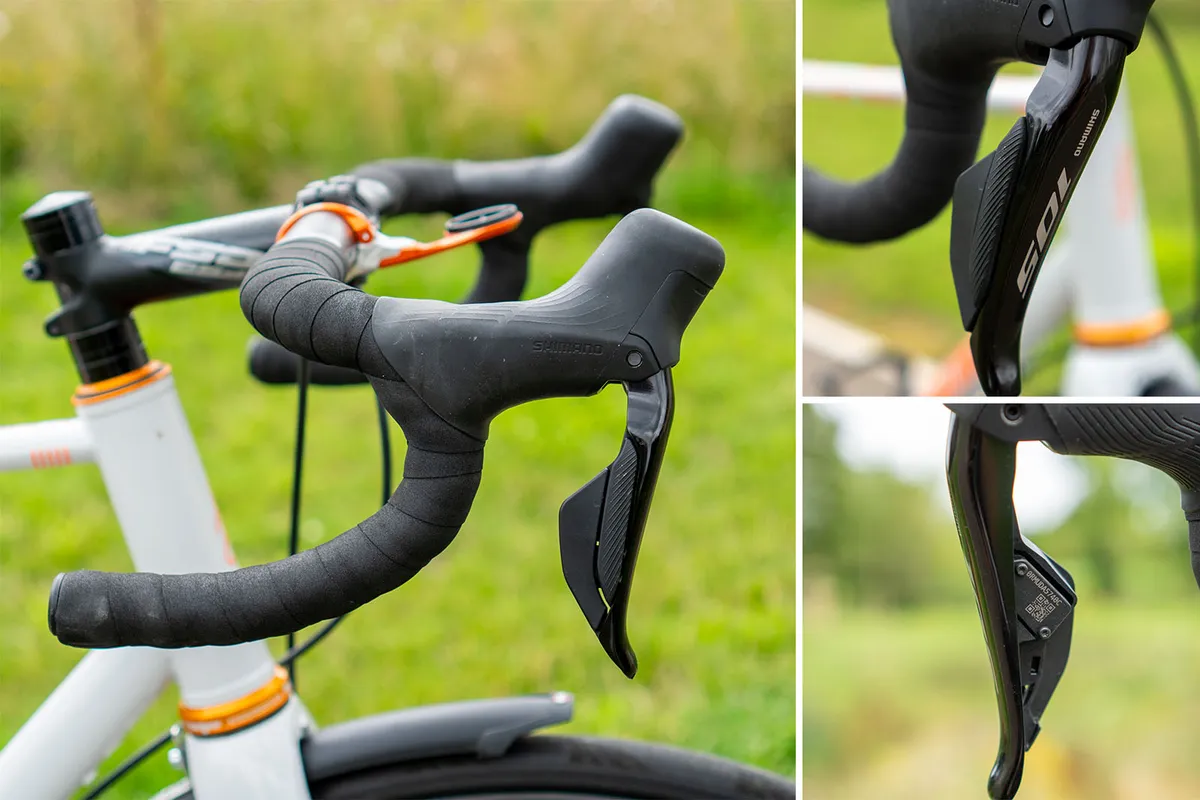
Instead of sticking with the wired shifter design of previous-generation Di2 groupsets, Shimano chose to emulate the latest electronic groupsets with wireless units.
As I suggested above, this makes setup a little easier versus also having to route Di2 cables alongside the hydraulic brake hoses (which obviously remain).
The latest generation shifter shape and size has trickled down from Dura-Ace and Ultegra. The shifters offer good leverage and feel whether I was riding tempo or tucked in an aero position with two fingers wrapped around the shrouded hood.
That the design is the same as the more expensive groupsets means that I need to look out for the 105 branding before being able to confidently tell them apart.
The alloy lever and some of the internals are made of slightly heavier materials, but that’s the same across all the components.
Also different is the loss of the hood-top buttons. Throughout the nine months I’ve been running the groupset, I’ve not missed them, even when I’ve switched to and from test bikes fitted with the groupsets that do include them.
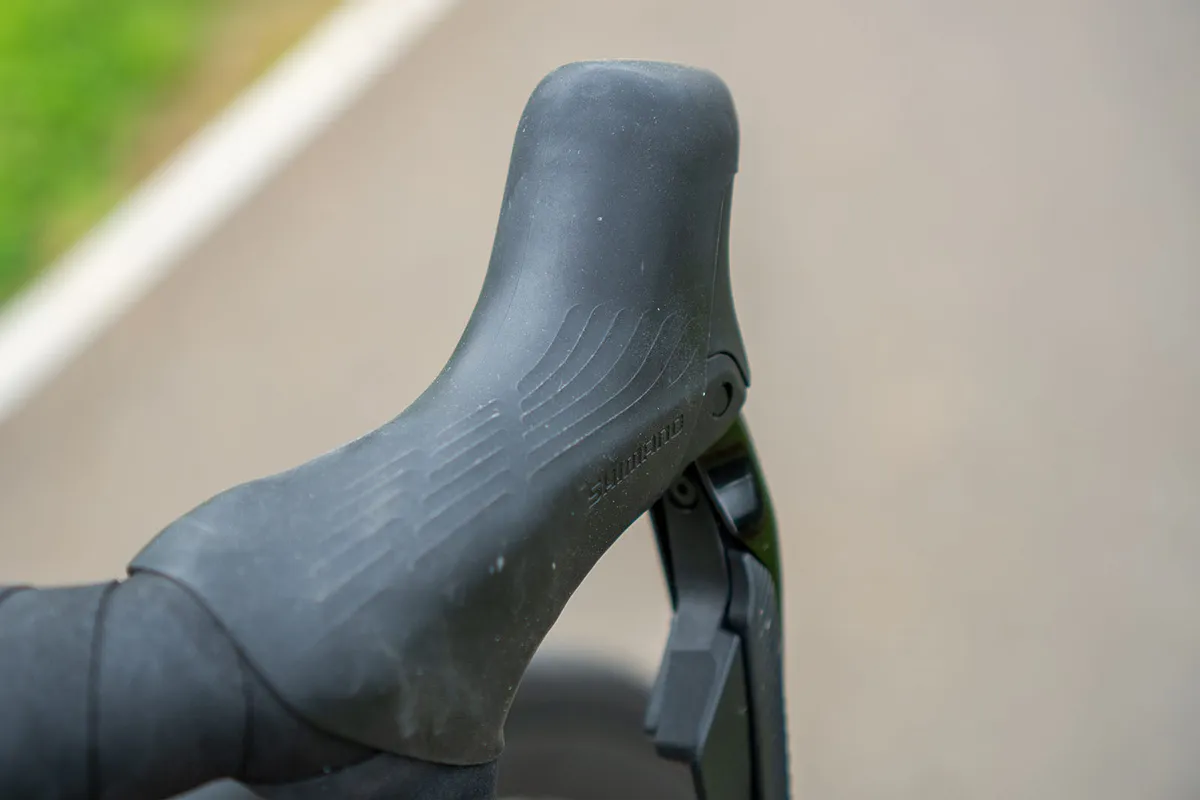
The upside of losing these buttons is that two CR1632 batteries need to be installed in each lever, which effectively doubles their battery life from two to four years (although in the interest of bringing you the best 105 Di2 review possible before Shimano replaces the groupset with a new one, I can’t yet verify that claim).
In use, the shift buttons feel the same as Dura-Ace and Ultegra Di2, but like Ultegra Di2, the larger shift paddle on either lever doesn’t have the slightly tacky treatment seen on the Dura-Ace models.
Simon felt Shimano could still do more to differentiate said buttons, and I must agree – it’s still possible to occasionally hit the wrong button and perform a shifting action you weren’t expecting.
With 105 Di2 R7100 – arguably more so than the others, given it’s more likely to be fitted to bikes challenged with wintry conditions, thanks to its relatively lower cost – the need for grip and positive identification is heightened when long-fingered gloves and cold hands are in the mix.
Those after a cheaper Di2 time trial setup or shifting on the tops may be disappointed that this groupset doesn’t allow for the installation of satellite shifters – something SRAM offers at all four levels of its electronic groupset offering.
Shimano 105 Di2 FD-R7150 front derailleur
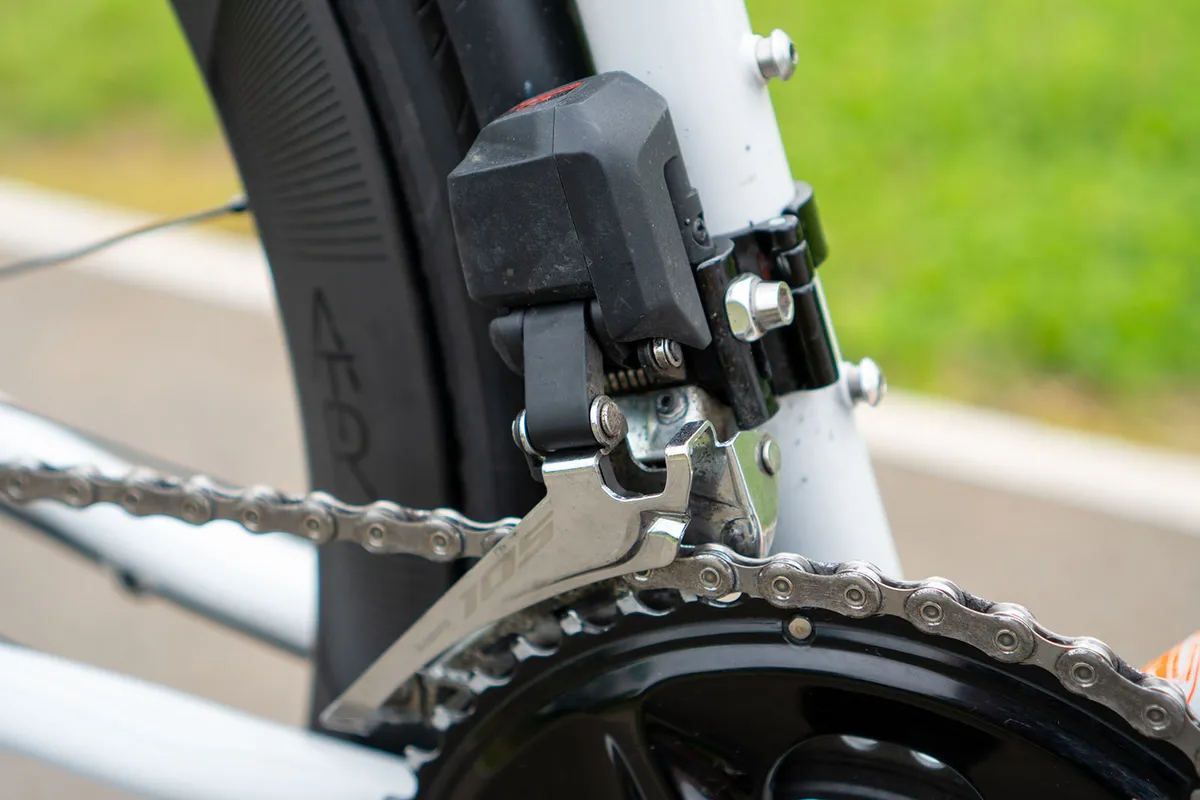
The front derailleur is where the first major concession to Dura-Ace and Ultegra Di2 is seen, and certainly noticeable when riding.
Externally, the 105 Di2 R7100 front derailleur shell is larger than the higher-tier models – for all intents and purposes, it's the same as the previous generation Dura-Ace Di2 R9150 and Ultegra Di2 R8070 groupsets.
Inside, the motor system that shifts the cage is also carried over from those older groupsets.
As a result, the shift performance here is identical to those groupsets, rather than the latest generation Dura-Ace and Ultegra derailleurs, which are said to be 45 per cent quicker.
Side by side with the latest Dura-Ace or Ultegra Di2 groupsets, shifting onto the big ring under load is noticeably slower here, but it’s still nigh-impossible to get wrong or to drop a chain (assuming, of course, the limits and indexing are set up correctly).
Dropping down to the small ring suddenly is practically identical in experience, just with the slight hesitancy that’s seen across all Shimano Di2 groupsets.
The fact is, though, each time I’ve used any 105 Di2 R7100-fitted bike after using either of its sibling groupsets, it’s taken only a few kilometres of riding before the difference blends into the background of the experience.
I will confess to finding the faster shift speed of Dura-Ace and Ultegra Di2 more exciting somehow, and the smaller derailleur bodies certainly look neater, but these are marginal impressions that shouldn’t detract much from a slick feeling experience.
Shimano 105 Di2 RD-R7150 rear derailleur
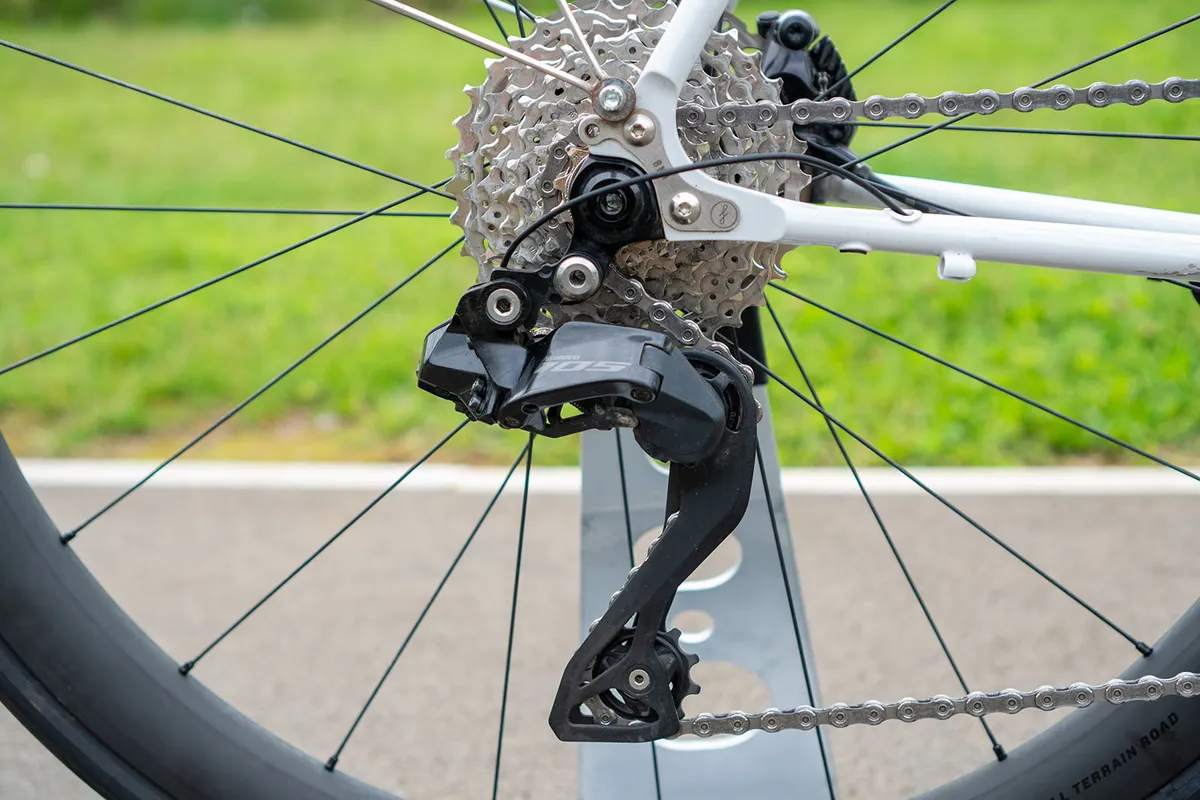
Compared to the front derailleur, the rear derailleur performs like a replica of the latest-generation Dura-Ace and Ultegra Di2 models.
Like those units, it houses the processor for the shifting system, the Bluetooth connectivity chip, and the charge port (the same USB-powered charge cable can be used across all of the latest Di2 groupsets).
Aesthetically, it has a simpler design than Shimano's higher-spec rear derailleurs with fewer sculpts in its construction, but 105 branding aside it remains similar enough to mistake for the more premium groupsets at a glance.
Shifting performance, in turn, is near-identical. With both Ultegra and 105 Di2 derailleurs side by side (set up identically in the E-Tube app), I can’t discern a speed difference between them following a press of either lever button.
However, when riding those same setups back to back, the 105 Di2 derailleur’s shifting occasionally feels marginally less immediate. I suspect this is down to the lack of Hyperglide+ profiling on the cassette sprockets (more to come on that).
The two flaws to note were the protective cap for the charge port, as well as the charge port connection.
On two occasions, the cap, which is attached by two flexible plastic extensions, came off the derailleur completely when I removed it from charging. It was a small job to reattach it, but it concerns me that it might one day work loose on a ride and be lost forever.
Sometimes, I also found the charge plug and socket difficult to align properly for a secure charging connection.
That said, this isn’t an issue isolated to 105 Di2 R7100. I've experienced the same across all levels of the latest Di2 groupsets.
The derailleur comes in one cage length, suitable for up to a 36t largest sprocket.
Officially, the tighter 11-30t cassettes available for Ultegra and Dura-Ace Di2 aren’t compatible with this rear derailleur, though our experience proves otherwise.
Shimano 105 FC-R7100 crankset and chainrings

The crankset and chainrings use Shimano’s Hollowtech II construction, whereby each crank arm is forged in two pieces and then bonded together.
As with the rest of the groupset, the alloy used here is heavier than on the more premium groupsets.
It has a 24mm diameter steel spindle and can be used with the vast majority of bottom bracket standards. The 4-bolt 110 BCD (bolt circle diameter) chainring pattern remains too.
Ostensibly, it’s a match for Dura-Ace and Ultegra Di2 in terms of design, though, and it looks it. Arguably, the shiny black finish appears more premium than Ultegra’s off-black matte finish.
You can have the FC-R7100 crankset in 50/34t (compact) or 52/36t (semi-compact) combinations.
I found the 50/34t combination perfect for the vast majority of riding I do on my Fairlight Strael (as a winter, commuter and audax workhorse), but the 52/36t option should be big enough for the vast majority of usage cases.
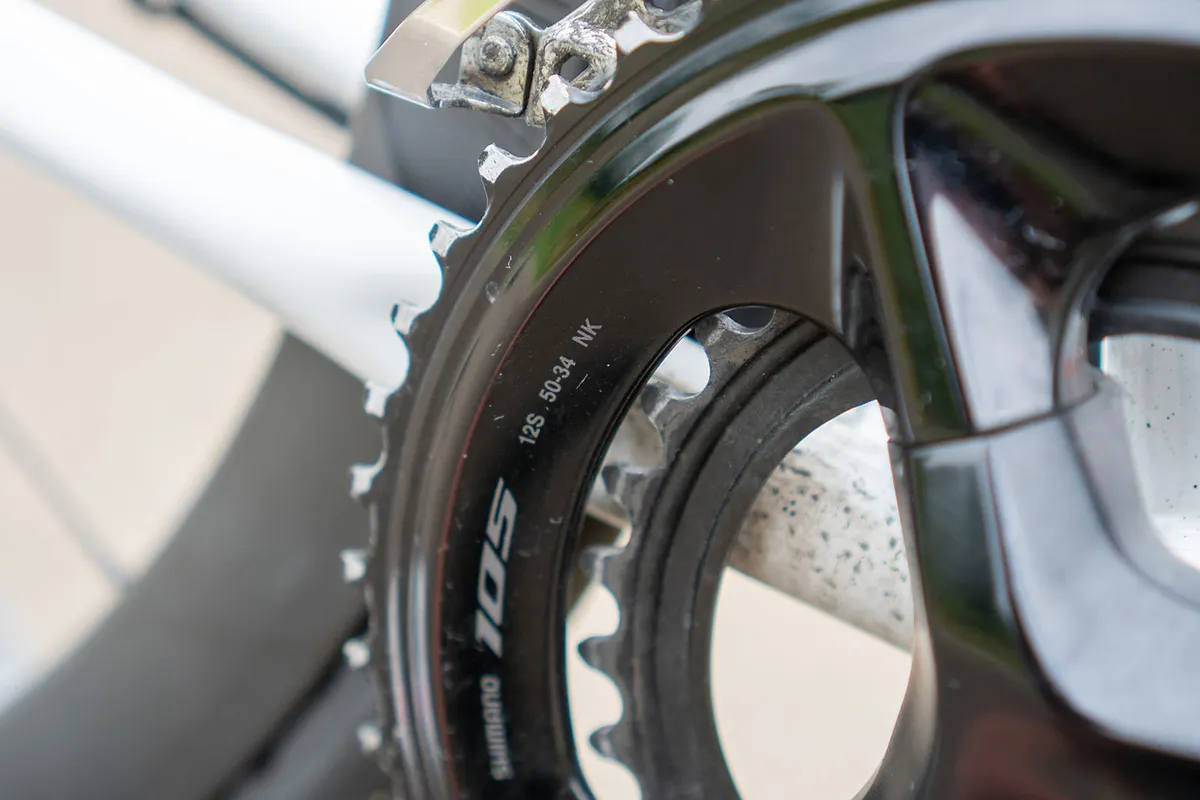
It’s reasonable to assume that Shimano reckons anyone strong enough to push a standard (or larger) crankset will naturally gravitate towards Dura-Ace anyway.
The cranks are available in five lengths ranging from 160 to 175mm, 5mm shorter at each extreme than Dura-Ace, but the same as Ultegra.
While the front derailleur isn’t as punchy as the Dura-Ace and Ultegra models, the chainrings accept the shifting chain quickly and easily, whether ramping up or dropping down.
Shimano doesn’t make a power meter version of the crankset, but models are starting to appear on the market from the likes of 4iiii.
Shimano 105 CS-R7101-12 cassette
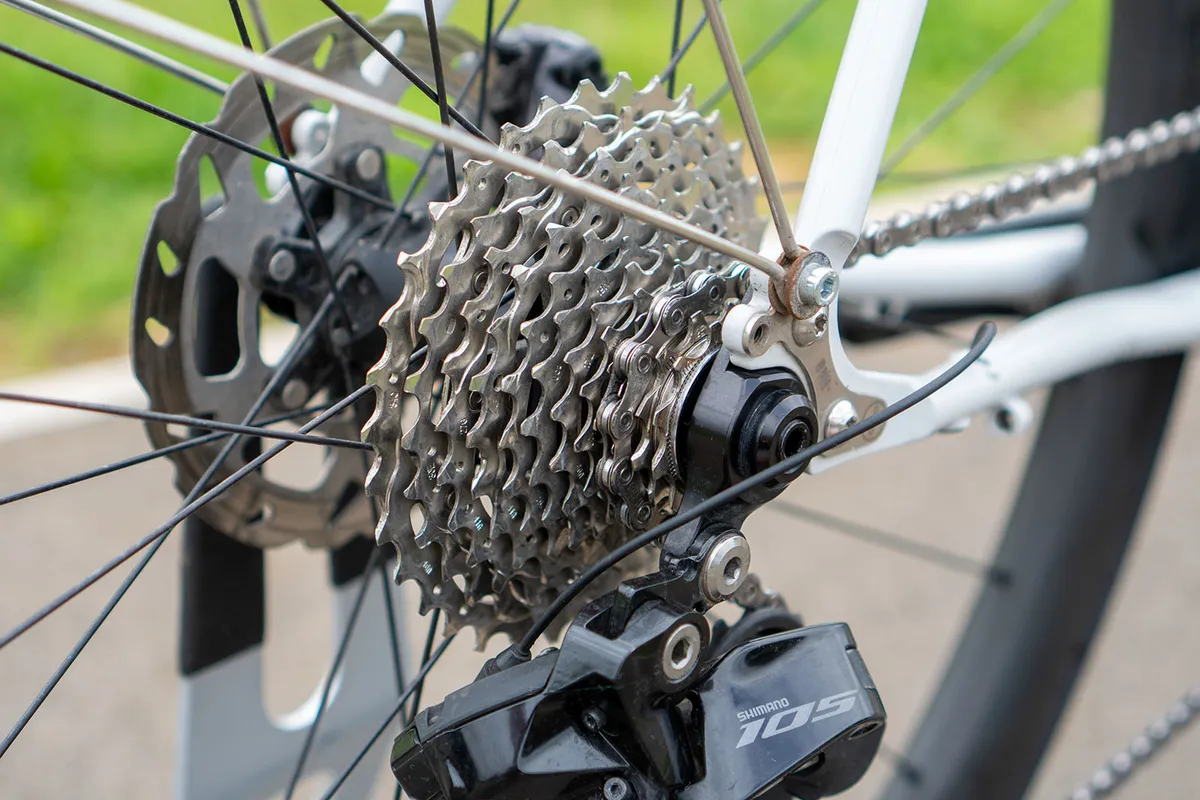
The 105-series cassette comes in one flavour: 11-34t.
I can understand some might lament the lack of a closer-range option for a more budget-friendly race setup, for example, but the range proved a real boon on my heavier steel test bike.
Recognising that a 105 groupset needs to appeal to a wide audience, the 34-tooth sprocket gives a small enough gear – with a compact chainset – to climb practically any hill.
I personally tend to leave it untouched, but I like riding with a gear in reserve (serving as a kind of intangible mental boost).
The gaps progress in single tooth increments for the first five sprockets (11-15t), two tooth increments for the next three (17, 19, 21t), before gapping out to three (24, 27, 30t) until that final 34t sprocket.
As I mentioned, smaller progressions deeper into the block might appeal to some who don’t want to shell out for the more expensive groupsets, but I never had a problem with the arrangement.
Shimano doesn’t officially support the swapping of cassettes between groupsets, but I ran an 11-30t Ultegra R8100 cassette with no noticeable issues.
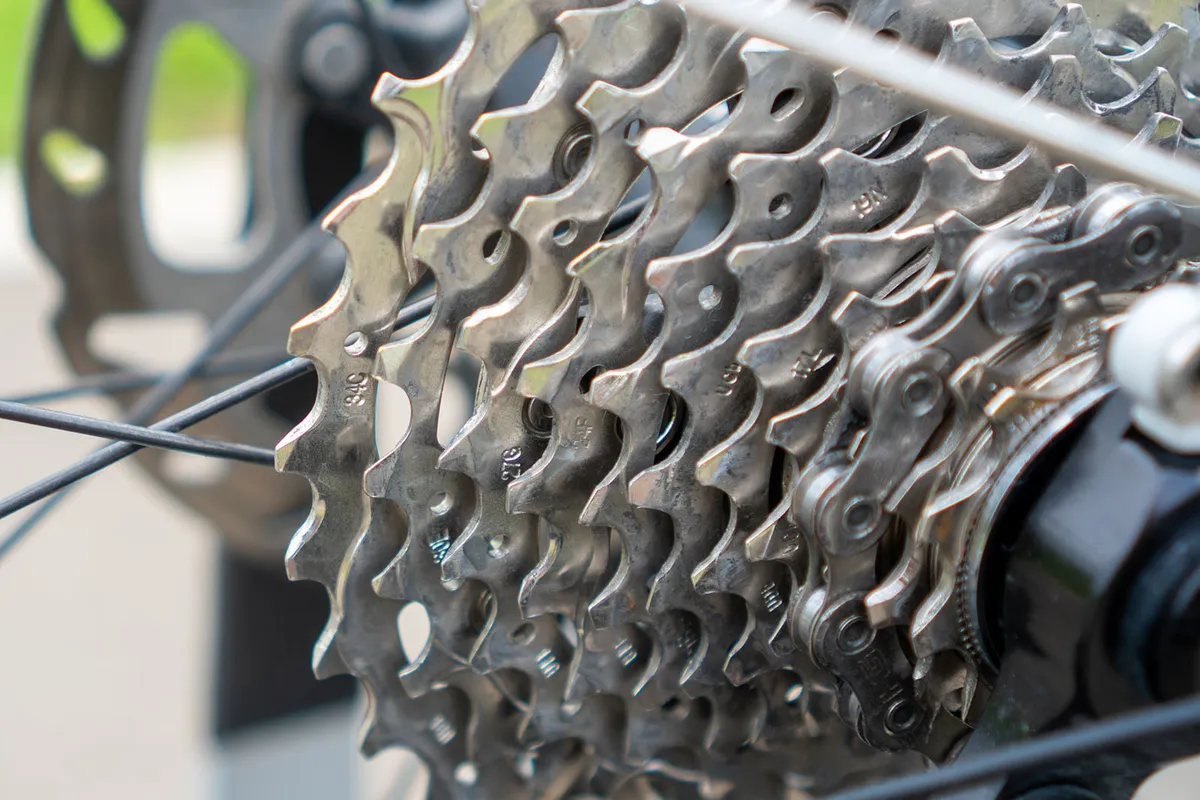
An 11-36t non-series cassette (CS-HG710-12) is also available for those who require an even easier gear.
Neither of these cassettes feature Shimano’s Hyperglide+ profiling on the teeth. Instead, they have ‘Hyperglide’ tech.
The difference is, once again, small, but the pedalling experience is slightly less smooth through the pedal stroke than I’ve felt with either Dura-Ace or Ultegra Di2 (which are standard-setters).
It’s also slightly louder as each chain link engages and disengages from the cassette sprocket, perhaps adding to the perception of reduced smoothness.
Of course, switching between groupsets regularly only serves to reveal this more and it might not otherwise be noticeable, but – perhaps more than any other factor – it’s what separates 105 Di2 R7100 from its siblings.
When you consider that the front derailleur shifts a hundred or so times, each one compacted in a space of a moment, while you pedal thousands of times almost constantly over the course of a given ride, the marginal difference can come to feel more significant.
My switch to a Hyperglide+ Ultegra cassette didn’t wholly dial this sensation out, but there are more factors that could be at play there.
Shimano SLX CN-M7100 12-speed chain
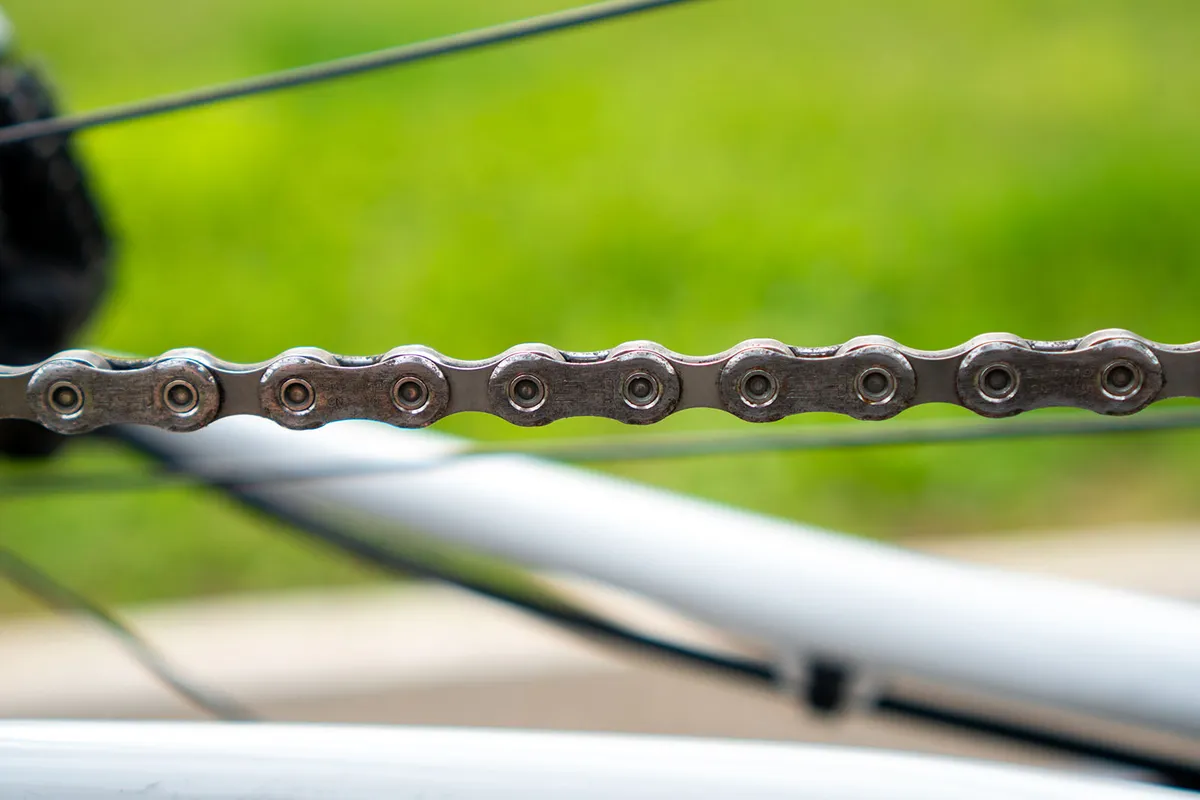
In something of a developing theme across its road groupsets, Shimano has nabbed the chain from its already 12-speed, SLX M7100 MTB groupset.
There’s little to remark about it. It works well with the assembly of drivetrain components it’s tasked with interacting with.
Braking performance
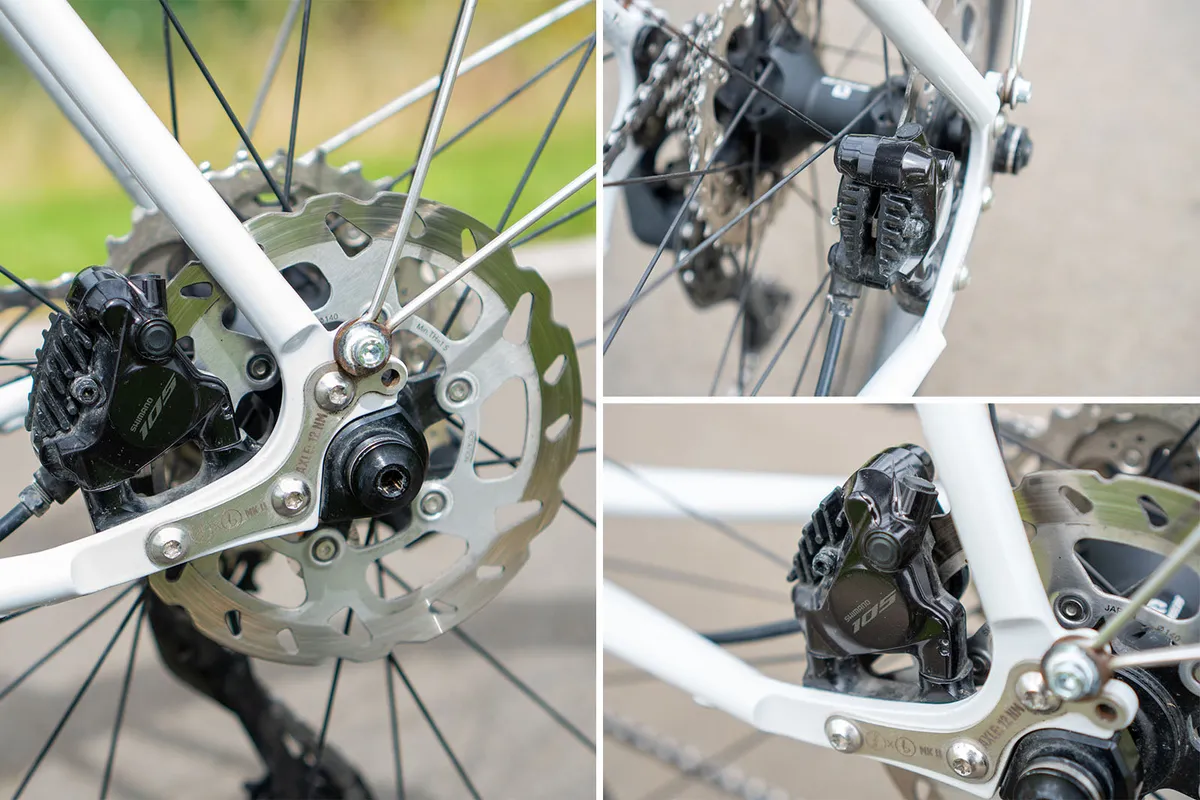
As I teased earlier, 105 Di2 R7100 braking is excellent and doesn’t unduly suffer from the lack of Servo Wave tech, which is reserved for Dura-Ace, Ultegra and GRX RX820.
Servo Wave essentially enables the pads to close on the rotor more easily in the earlier parts of the throw, before offering more modulation as you squeeze harder.
Here, the throw-to-piston compression ratio is more linear (as it was for previous generations of Shimano disc brake groupsets). This means that comparatively more aggressive pulling of the levers is needed to achieve the same braking force, especially in the earlier phase of the action.
Interestingly, I found that I rarely missed the presence of Servo Wave, despite noticing it when jumping onto a bike which had it – the opposite of the theory that absence makes the heart grow fonder.
The SM-RT70 rotors lack the Freezr heat-dissipation fins of the Dura-Ace or Ultegra models, but I struggled to feel any brake fade under heavy and repeated load.
Perhaps most importantly, the calipers have seen a trickle-down design from those groupsets, with a slimmer overall shape, yet with 10 per cent greater pad clearance for the rotors.
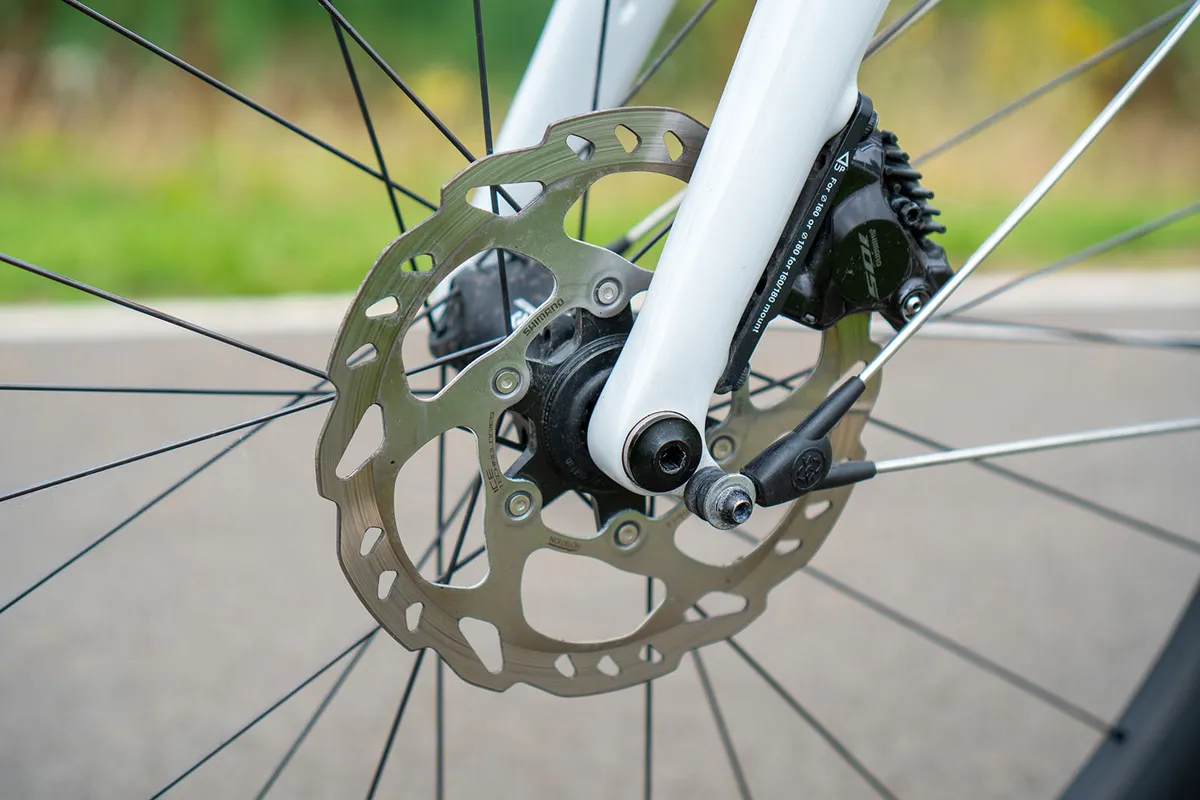
I’m delighted to see this make it to the 105 Di2 R7100 groupset – aside from misfiring shifting, nothing is more annoying than a rubbing brake pad and rotor.
The incidence of this is noticeably reduced versus the previous 105 R7020 calipers, but still not dialled out completely.
Squealing in wet conditions isn’t overly common, but contaminants (such as oil from a dirty road surface) will still cause some noise.
In my experience, both rotor rub and wet weather squealing are things that the premium groupset’s latest CL900 and CL800 rotors go further to address. Both of these can be used with the 105 calipers, should you wish.
Fundamentally, though, achievable power is still more than enough – your tyre adhesion is always the limiting factor – while modulation even without Servo Wave is excellent.
Has Shimano cut any electronic features from 105 Di2 compared to Dura-Ace or Ultegra Di2?
In short, no.
While support for optional satellite shifters has been dropped, along with the physical hood-top buttons, the functionality of the electronic system and E-Tube Project app is identical.
When you pair the app to the brain in the rear derailleur, and associate the wireless levers, only the hood-top buttons are ‘missing’.
The same ability to customise the shift buttons, shifting ferocity and multi-shifting (within the limits of the hardware), index and set limits, and update the firmware are all present and correct.
The system is also capable of running in standard, semi-synchro and full-synchro shifting modes.
Simon offers a good summation of the positives and negatives of these modes in his Dura-Ace Di2 R9200 review, although it’s a reflection of personal taste that I do prefer to set up semi-synchro shifting whenever possible.
Weight
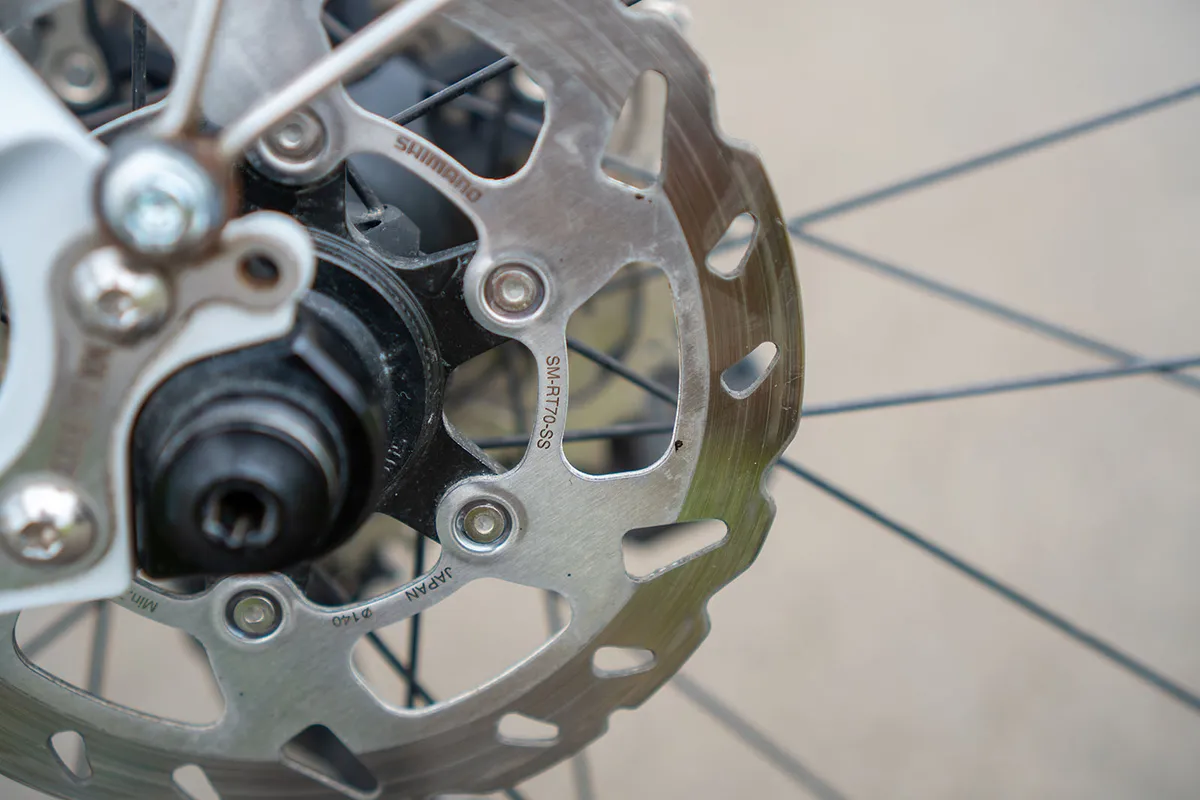
On paper, weight is where 105 Di2 gives up most to Dura-Ace and Ultegra Di2.
When we first got our hands on this groupset, we totted it up to 2,950g.
This compares to a Shimano-claimed 2,716g weight for an Ultegra R8100 Di2 groupset.
Whether a 234g difference matters or not will be up to you. If weight is your primary concern above all else, of course, this isn’t where you should be shopping.
All else being equal, though, for most riders it’s unlikely that this weight difference is going to make much difference to how fast you can climb a hill, and even less when riding on the flat.
In reality, I didn’t specifically notice the groupset’s weight on any test bike, as well as my own (heavier) steel Fairlight Strael 3.0, compared to riding one with Ultegra R8100 Di2.
The key for most people will be when they choose to spec the groupset on a new bike. Naturally, such a bike will usually come with heavier and lower-tier components, creating larger differences between builds. Of course, in this case, all things are certainly not equal.
However, overall, I’m satisfied that – unless you really do want the lightest build available – 105 Di2’s weight isn’t going to ruin your ride experience.
| | Claimed Weight (g) | Actual Weight (g) |
|---|---|---|
| Shifters | 423 | 442 |
| Crankset | 765 | 767 |
| Front derailleur | 142 | 138 |
| Rear derailleur | 302 | 301 |
| Cassette | 361 | 360 |
| Chain and quick link | 275 | 278 |
| Battery | 53 | 53 |
| Cables | 19 | 21 |
| Brake calipers and hoses | 282 | 333 |
| Rotor | 286 | 253 |
| Total | 2,992 | 2,950 |
Pricing and value

The value conundrum is one that challenges almost everyone. What represents good value to one person won’t to another.
When it comes to 105 Di2 R7100, there was hope that Di2 arriving at Shimano’s third tier would herald a new era of affordable electronic shifting.
Sadly, that’s not the case, with the groupset costing around £1,730 / $1,890 / €1,869 (give or take a small amount for specific component choices) at RRP.
As always with Shimano products, real-world prices can vary significantly. But it’s fair to say 105 Di2 hasn’t yet made electronic groupsets ‘cheap’.
There’s no previous iteration to compare it to, of course, but the recently launched mechanical 12-speed 105 R7100 groupset costs around £800 less (again, at RRP).
Perhaps more pertinently to those wanting to consign mechanical shifting to their own history book, the nominally same-level SRAM Rival eTap AXS has a retail price of around £1,268.

When you pose both head-to-head, there are some differences in their approaches, but having ridden both it’s hard to justify the RRP price discrepancy.
That assessment changes when real-world prices are in the mix, though. At the time of publication, deals on 105 Di2 can be found online, with some retailers selling a groupset for less than £1,000.
Looking upwards, Ultegra Di2 R8100 costs £2,332.90 (around £600 more) at RRP, but can also be bought in the real world for around £1,500.
Given that the groupset offers an identical experience to Dura-Ace Di2 R9200, save for the small weight penalty, I’d argue this is where many keen road riders might wish to put their money.
That said, if your budget won’t stretch that far, or you don’t care about having all the very latest tech Shimano can offer today, 105 Di2 R7100 doesn’t disappoint.
Shimano 105 Di2 R7100 bottom line
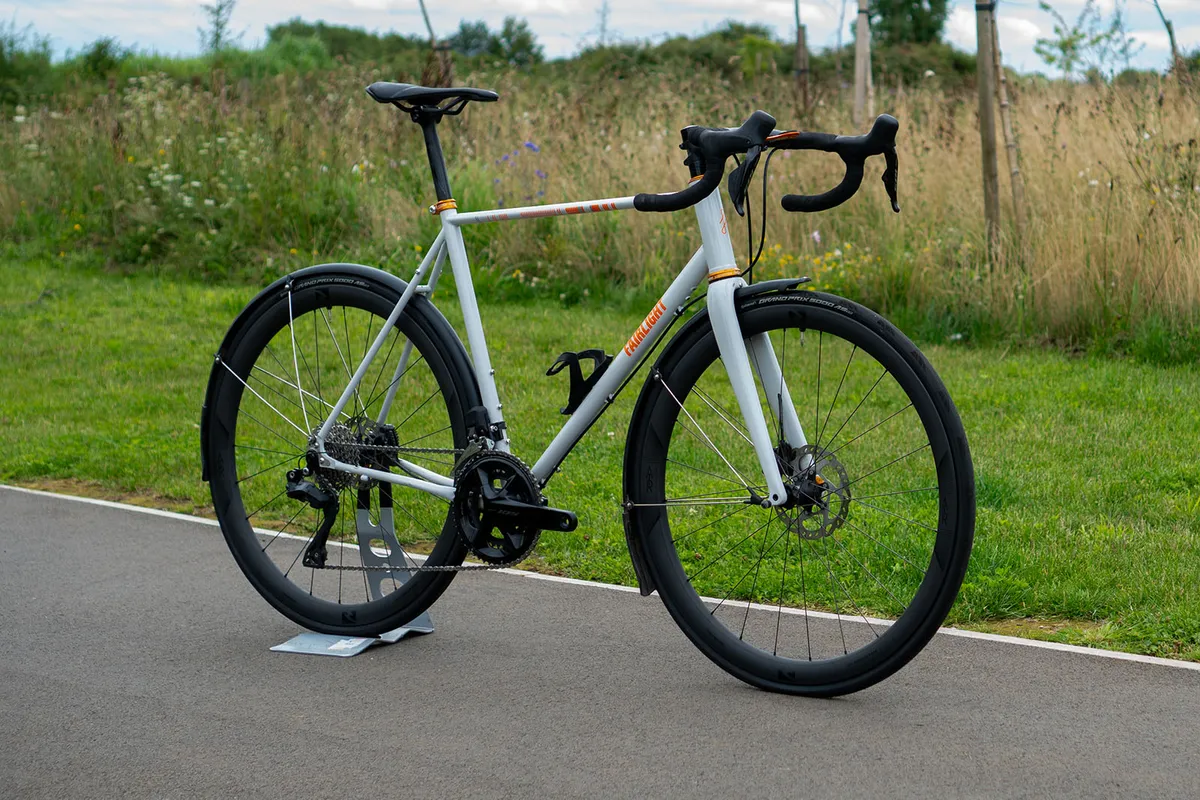
Fundamentally, Shimano 105 Di2 R7100 is an excellent-performing groupset.
It packs the efficiency and reliability of Di2 shifting in a cheaper-than-Ultegra Di2 R8100 package, without cutting any tech that makes a large difference to overall performance.
Having said that, it is challenged keenly by competitors. SRAM Rival eTap AXS offers a viable alternative (with a cheaper RRP), while I think the small improvements Ultegra Di2 R8100 features make that groupset an enticing prospect, if you can afford it.
Of course, if you’re set on owning a Shimano Di2 groupset and your budget can’t stretch so far as Ultegra, then 105 Di2 R7100 still packs a serious performance punch.
It’s just a shame that, however good it is in isolation, 105 Di2 R7100 isn’t quite the easy buy I – and many others – might have hoped it would be.
Product
| Brand | Shimano |
| Price | €1869.00, £1730.00, $1890.00 |
| Weight | 2950g |
| br_whatWeTested | as tested |
Features
| Speed | 12 |
| Brake type | hydraulic_disc |
| Cassette options | 11-34t |
| Chainring options | 50/34t (compact) or 52/36t (semi-compact) |

